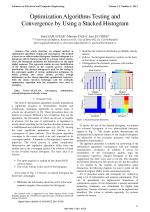| 1/2011 - 2 |
Optimization Algorithms Testing and Convergence by Using a Stacked HistogramZAPLATILEK, K. |
| Extra paper information in |
| Click to see author's profile in |
| Download PDF |
Author keywords
MATLAB, convergence, optimization, stacked histogram, stochastic system
References keywords
zaplatilek(4), optimization(4), group(4), delay(4), algorithm(4)
Blue keywords are present in both the references section and the paper title.
About this article
Date of Publication: 2011-02-27
Volume 11, Issue 1, Year 2011, On page(s): 11 - 16
ISSN: 1582-7445, e-ISSN: 1844-7600
Digital Object Identifier: 10.4316/AECE.2011.01002
Web of Science Accession Number: 000288761800002
SCOPUS ID: 79955947165
Abstract
The article describes an original method of optimization algorithms testing and convergence. The method is based on so-called stacked histogram. Stacked histogram is a histogram with its features marked by a chosen colour scheme. Thus, the histogram maintains the information on the input digital sequence. This approach enables an easy identification of the hidden defects in the random process statistical distribution. The stacked histogram is used for the testing of the convergent quality of various optimization techniques. Its width, position and colour scheme provides enough information on the chosen algorithm optimization trajectory. Both the classic iteration techniques and the stochastic optimization algorithm with the adaptation were used as examples. |
| References | | | Cited By «-- Click to see who has cited this paper |
| [1] P. Ziska, M. Laipert, "Analog Group Delay Equalizers Design based on Evolutionary Algorithm," Radioengineering, 2006, vol. 15, no. 1, pp. 1-5.
[2] K. Deb, A. Anand, D. Joshi, "A computationally efficient evolutionary algorithm for real parameter optimization," Evolutionary Computation Journal, 2002, vol. 10, no. 4, pp. 371-395. [CrossRef] [PubMed] [3] K. Zaplatilek, "Analogue Filter Group Delay Optimization Using a Stochastic Approach," International Journal of Numerical Modelling, 2010, vol. 23, no. 3, pp. 215-230. [4] K. Zaplatilek, P. Ziska, K. Hajek, " Practice Utilization of Algorithms for Analog Filter Group Delay Optimization," Radioengineering, April 2007, vol. 16, no. 1, pp. 7-15. [5] K. Zaplatilek, K. Hajek, "Efficient Algorithm for Group Delay Equalization of Analogue Filters," Proc. of GSPx - International Signal Processing Conference, April 2003, Dallas, TX, USA. [6] Q. Zhang, J. Sun, E. P. K. Tang, J.A. Ford, "Hybrid estimation of distribution algorithm for global optimization," Engineering Computations, 2003, vol. 21, no. 1, pp. 91-107. [CrossRef] [Web of Science Times Cited 61] [SCOPUS Times Cited 81] [7] J. H. Mathews, K. K. Fink, "Numerical Methods Using MATLAB," Prentice-Hall Inc., 2004. [PermaLink] [8] M. Talpa, K. Zaplatilek, "Histogram with higher information capacity," Elektrorevue, 2010, no. 62, 5p. Available: http://www.elektrorevue.cz. Published in Czech. Web of Science® Citations for all references: 61 TCR SCOPUS® Citations for all references: 81 TCR Web of Science® Average Citations per reference: 7 ACR SCOPUS® Average Citations per reference: 9 ACR TCR = Total Citations for References / ACR = Average Citations per Reference We introduced in 2010 - for the first time in scientific publishing, the term "References Weight", as a quantitative indication of the quality ... Read more Citations for references updated on 2025-05-28 04:05 in 16 seconds. Note1: Web of Science® is a registered trademark of Clarivate Analytics. Note2: SCOPUS® is a registered trademark of Elsevier B.V. Disclaimer: All queries to the respective databases were made by using the DOI record of every reference (where available). Due to technical problems beyond our control, the information is not always accurate. Please use the CrossRef link to visit the respective publisher site. |
Faculty of Electrical Engineering and Computer Science
Stefan cel Mare University of Suceava, Romania
All rights reserved: Advances in Electrical and Computer Engineering is a registered trademark of the Stefan cel Mare University of Suceava. No part of this publication may be reproduced, stored in a retrieval system, photocopied, recorded or archived, without the written permission from the Editor. When authors submit their papers for publication, they agree that the copyright for their article be transferred to the Faculty of Electrical Engineering and Computer Science, Stefan cel Mare University of Suceava, Romania, if and only if the articles are accepted for publication. The copyright covers the exclusive rights to reproduce and distribute the article, including reprints and translations.
Permission for other use: The copyright owner's consent does not extend to copying for general distribution, for promotion, for creating new works, or for resale. Specific written permission must be obtained from the Editor for such copying. Direct linking to files hosted on this website is strictly prohibited.
Disclaimer: Whilst every effort is made by the publishers and editorial board to see that no inaccurate or misleading data, opinions or statements appear in this journal, they wish to make it clear that all information and opinions formulated in the articles, as well as linguistic accuracy, are the sole responsibility of the author.



